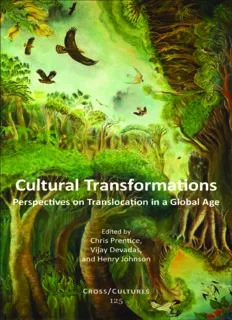
Cultural Transformations. (Cross Cultures: Readings in the Post Colonial Literatures and Cultures in English) PDF
Preview Cultural Transformations. (Cross Cultures: Readings in the Post Colonial Literatures and Cultures in English)
Cultural Transformations CROSS Readings in Post/Colonial ULTURES Literatures and Cultures in English 125 SERIES EDITORS Gordon Collier Bénédicte Ledent Geoffrey Davis (Giessen) (Liège) (Aachen) CO-FOUNDING EDITOR (cid:103)Hena Maes–Jelinek Cultural Transformations Perspectives on Translocation in a Global Age Edited by Chris Prentice, Vijay Devadas, and Henry Johnson Amsterdam - New York, NY 2010 Cover Painting: Zeke Wolf, Vertical Forest (2008) (oil on canvas, 700 cm x 1200 cm) Courtesy of the artist www.zekewolf.co.nz Cover design: Pier Post The paper on which this book is printed meets the requirements of “ISO 9706:1994, Information and documentation - Paper for documents - Requirements for permanence”. ISBN: 978-90-420-3003-9 E-Book ISBN: 978-90-420-3004-6 © Editions Rodopi B.V., Amsterdam – New York, NY 2010 Printed in The Netherlands Table of Contents ————————— Acknowledgements vii Illustrations ix Introduction CHRIS PRENTICE, VIJAY DEVADAS, AND HENRY JOHNSON xi PART 1: TEXTUAL TRANSLOCATIONS Earth, World, Planet: Where Does the Postcolonial Literary Critic Stand? DIANA BRYDON 3 Affirming Diasporas as National Antinomies VIJAY DEVADAS 31 Australian Infernos: Janette Turner Hospital ’s Translation of Dante’s Hell into Contemporary Australia MARY MCLAUGHLIN 51 Between Mother Tongue, Grandfather Tongue and Foreign Tongue: A Turk in Translation ALYTH GRANT AND KATE ROY 73 A Poetics of Translocation: Yang Lian’s Auckland and Lyn Hejinian’s Leningrad JACOB EDMOND 105 PART 2: MUSICAL TRANSLOCATIONS Fusión Rapa Nui: Mito Manutomatoma and the Translocation of Easter Island Music in Chilean Popular Culture DAN BENDRUPS 137 Interactive Environments and the Context of Heritage: Culturally Engaged Research and Facilitation in Small-Island Societies PHILIP HAYWARD 159 Constructing an ‘Other’ from Your ‘Own’: Localizing, Nationalizing, and Globalizing Nnzu (Nenes) HENRY JOHNSON 179 PART 3: VISUAL TRANSLOCATIONS Rejecting Words: Illiteracy, Silence, and the Visual PAOLA VOCI 209 Integral Culture: Agora-Phobia at the Polynesian Cultural Centre CHRIS PRENTICE 239 The Kumars at No. 42: The Dynamics of Hyphenation, or Did Sanjeev Take Parkie Down? BRETT NICHOLLS AND ANDY BARRATT 275 Transl(oc)ating the P layer: Are Some Computer- and Video-Game Players Also Unpaid Workers in the Information Economy? SIMON RYAN 307 Notes on Contributors 321 Index 325 Acknowledgements ————————— We would like to thank all the contributors to the volume for their work and for their continued support and patience throughout this project. We would also like to express appreciation to John Drummond, who con- vened the University of Otago Cultural Transformations Research Net- work that brought these scholars together, to the Division of Humanities, University of Otago, for financial support for the Network’s activities, and to the University of Otago Departments of English, Music, and Media, Film and Communication Studies, for generous financial and administra- tive support. We are grateful to Andy Barratt and Stephanie Broege for their input as research assistants at early stages in the project, to Linda Brown for handling further administrative matters, and to Gordon Collier, Technical Editor for Rodopi’s Cross/Cultures series, for his painstaking work in the preparation of the manuscript. Finally, we are grateful to artist Zeke Wolf, who kindly permitted us to use his work for the cover image. Illustrations ————————— Figure 1: The Rapa Nui Pub in Bellavista, Santiago, decorated with characteristic Rapanui symbols. Photograph by the author 152 Figure 2: Mito y Fusión Rapa Nui at the Tahai archaeological site. Photograph by the author 152 Figure 3: The ‘cow-piss’ character 228 Figure 4: “Book from the Sky” (1987–91), Xu Bing. Hand printed books, ceiling and wall scrolls printed from wood letter- press type using false Chinese characters. Dimensions vari- able, Installation view at “Crossings,” National Gallery of Canada, Ottawa (1998), dimensions variable. Courtesy Xu Bing Studio. 233 Figure 5: One of Xu Bing’s character blocks from “Book from the Sky” (1987–91). Detail of one set (four volumes) of hand- sewn thread-bound books printed from woodblock and wood letterpress type using false Chinese characters, each volume 46 x 30 cm (closed). Courtesy Xu Bing Studio. 234 Figure 6: The entrance/exit of the PCC McDonald’s 248 Figure 7: Mural – saluting the US flag 248 Figure 8: Photograph housed inside 250 Figure 9: Publicity poster for the PCC 250 Figure 10: Spaces of arrival – entry 259 Figure 11: Spaces of arrival – restaurant forecourt 259 Figure 12: Mori canoe pageant 262 Figure 13: Samoan ‘language lesson’ performance 262 Figure 14: Advertising the PCC 269 Figure 15: Advertising the PCC 271 (Figures 6–13: all photos by Chris Prentice.) Introduction Cultural Transformations: Perspectives on Translocation in a Global Age ————————— CHRIS PRENTICE, VIJAY DEVADAS, AND HENRY JOHNSON, We need to situate the debate about identity within all those histo- rically specific developments and practices which have disturbed the relatively ‘settled’ character of many populations and cultures, above all in relation to the processes of globalization […] and the processes of forced and ‘free’ migration which have become a global phenome- non of the so-called ‘postcolonial’ world.1 T RANSLATION HAS EMERGED as a central problematic of our times. With its etymological root suggesting to ‘carry across’, ‘translation’ implies translocation. In the wake of Walter Benja- min’s account of translation as a mode that is never static but performs, striving not to be as close as possible to the original but to renew it, trans- lation further implies transformation. Translation applies to media, cul- tures, and peoples as much as to languages. Diasporic population flows and the additional culture flows brought about by technology and the glo- balization of the media are transforming our world, globally and locally. Many of the world’s peoples are living ‘in translation’: inhabiting trans- 1 Stuart Hall, “Introduction: Who Needs Identity,” in Questions of Cultural Identity, ed. Stuart Hall & Paul du Gay (London, Thousand Oaks CA & New Delhi: Sage, 1996): 4.
Description: